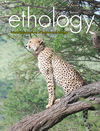|
Journal
EthologyMore Press Releases related to this journalEdited by: Jutta Schneider and Susan A. Foster (Editors-in-Chief)
Print ISSN: 0179-1613 Online ISSN: 1439-0310
Impact Factor: 1.697

More Press Releases in: |
Media ToolkitContact Publicity to:
|
Vultures use Face Flushing Technique for Instant Status Updates
Tech savvy humans who use social media sites to instantly update their ‘statuses’, may be behaving like vultures who use ‘face flushing’ as a visible way of instantly updating their own status when interacting with peers and rivals. Research, published in Ethology, reveals how the ability to rapidly change skin colour is a key form of interaction for vultures, especially for displays of dominance.
The ability to rapidly change skin colour has been well documented in reptiles and fish, which use specialist cells to disperse and concentrate pigments. However, the ability can also be found in some mammals and bird species which exhibit bare skin, such as the vulture.
“Vultures have un-feathered sections of skin on their heads which can become bright red when blood flow is increased, a technique known as flushing,” said Dr Andrew Bamford from Nottingham University. “The advantage in using their bare skin as a signal is that colour changes can occur more rapidly than in feathers or fur, provide up-to-date information on status.”
Dr Bamford and co-authors studied Lappet-faced vultures, Aegypius tracheliotos in northern Namibia to discover how this face flushing ability is used. The team placed food at spots where vultures are known to gather at sunrise and monitored the wild birds’ interactions.
The team found that adults with flushed heads won the majority of social interactions against adults with pale heads and juveniles. However, adults with pale heads were not successful against juveniles.
The team also discovered that a previously unnoticed blue colouration also has an impact on the outcome of interactions. Adults with blue throats won the majority of their interactions with pale or red throated individuals.
“Our study has shown colouration correlates with the outcome of interactions in gatherings of lappet-faced vultures,” concluded Bamford. “Previously interaction was thought to depend on aggressive behavior, but face flushing status plays an important part in the initiation of, and response to, interaction from other vultures.”


